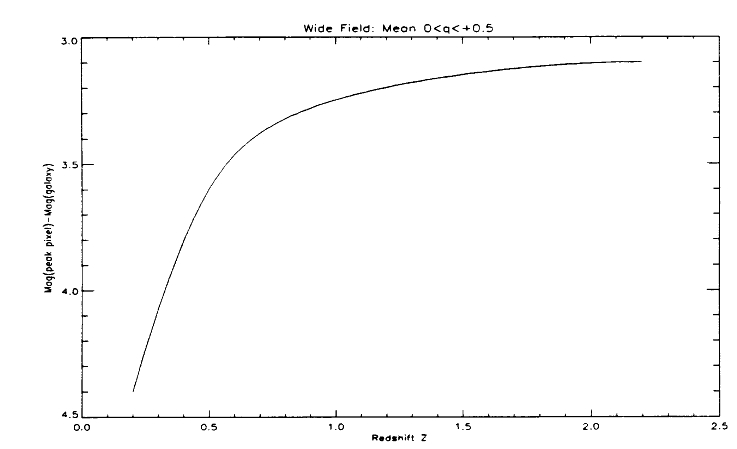 we have a count rate in e- s-1 pixel-1 of
we have a count rate in e- s-1 pixel-1 of


The calculations for extended sources are nearly identical to those for point sources. The easiest procedure is to compute the SNR per detector pixel, and then adjust this value if the total SNR is required for an area encompassing many pixels.
In general, one will have the target magnitude or flux per square arcsecond. To compute the flux per pixel for the PC one merely multiplies the flux per square arcsecond by 0.00207, or instead, adds the value 6.7 to the magnitude per square arcsecond to get the necessary magnitude per PC pixel. For the WFC, one either multiplies the flux per square arcsecond by 0.00993, or adds 5.0 to the magnitude per square arcsecond. Equations 6.2, 6.3, and 6.4 can be rewritten including these factors as below.
For the PC camera, sources with stellar spectra, and V surface brightness per square arcsecond  we have a count rate in e- s-1 pixel-1 of
we have a count rate in e- s-1 pixel-1 of

For power law sources where  is the target flux in units of ergs cm-2 s-1 Hz-1 arcsec-2 we have
is the target flux in units of ergs cm-2 s-1 Hz-1 arcsec-2 we have

And finally for emission line sources where  is the flux in ergs cm-2 s-1 arcsec-2 we have
is the flux in ergs cm-2 s-1 arcsec-2 we have

where the emission line wavelength  is in Angstroms.
is in Angstroms.
For the WFC cameras and stellar sources with V surface brightness per square arcsecond  we have a count rate in e- s-1 pixel-1 of
we have a count rate in e- s-1 pixel-1 of

For power law sources where  is the target flux in units of ergs cm-2 s-1 Hz-1 arcsec-2 we have
is the target flux in units of ergs cm-2 s-1 Hz-1 arcsec-2 we have

And finally for emission line sources where  is the flux in ergs cm-2 s-1 arcsec-2 we have
is the flux in ergs cm-2 s-1 arcsec-2 we have

where the emission line wavelength  is in Angstroms.
is in Angstroms.
The generalized SNR per pixel per exposure for an extended source is then obtained simply by setting the sharpness to unity in Equation 6.5:

| Parameter |
Description |
Units |
Approx. Value |
Better Value |
|---|---|---|---|---|
| Pobject |
object count rate |
e- s-1 pixel-1 |
|
Equations 6.9 to 6.12 |
| Pdark |
dark count rate |
e- s-1 pixel-1 |
0.004 |
Table 4.2; Eqn 4.1 on page 90 |
| Psky |
sky count rate |
e- s-1 pixel-1 |
Eqn 6.7 (PC) or 6.10 (WFC) |
|
| Pbackground |
count rate from background light (if any) |
e- s-1 pixel-1 |
|
Eqn 6.7 (PC) or 6.10 (WFC) |
| readnoise |
|
e- |
ATD-GAIN=7 use 5.31 ATD-GAIN=15 use 7.5 |
|
| t |
exposure time |
s |
|
|
| 1Default value is ATD-GAIN=7. |
Since many observations of extended sources are for galaxies in broad-band filters, a few rules of thumb can be useful. Saturation is seldom a concern, except in very bright spots such as the inner core of ellipticals and of some bulges. Count rates for spiral galaxies range typically from 2 to 0.01 e- pixel-1 s-1 (and lower) for filters such as F555W, F606W, F702W, and F814W; the lower end of the range corresponds roughly to the de Vaucouleurs D25. Count rates are significantly lower in blue and UV filters. Spiral structure can typically be traced reasonably well with total exposures of 3000 seconds or longer in the above filters.
For galaxies of very small angular size at redshifts of cosmological interest, the image may cover a small number of pixels; thus the detection of such objects follows rules similar to those of point sources. However, the fraction of light falling in the central pixel is smaller for most galaxies than it is for true point sources. The approximate magnitude difference between the light falling in the central pixel and the entire galaxy is plotted in Figure 6.1 for a typical giant elliptical galaxy, as a function of redshift. For other types of galaxies, a morphological term can be added to the values (for example, 0.6 magnitudes for lenticulars, 0.7 for S, 0.8 for Sab, 0.9 for Sbc, 1.2 for Scd, and 1.8 for Irr). These values must be increased by an additional 1.7 magnitudes for the PC.
Figure 6.1: Giant Elliptical Galaxy.


|
Space Telescope Science Institute http://www.stsci.edu Voice: (410) 338-1082 help@stsci.edu |